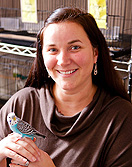News
Lab echoes with calls of the wild
-
 Print
Print -
 Comments
Comments
-

“By studying the different aspects of communication in different animals and using different disciplines, we can begin to understand the acoustic communication puzzle more clearly.”
Micheal Dent is up to her neck in parakeets.
An associate professor of psychology at UB, Dent conducts extensive and well-regarded research into the perception and processing of complex acoustic stimuli in birds and small mammals—from cats to mice—using both behavioral and physiological techniques. Her studies are replete with discussions of tiny bones and ear canals, acoustic signals, sound-identification thresholds and the way hearing influences the animals’ ability to converse with members of its species.
Dent’s work elucidates not only how animals survive in natural environments, but how and to what extent the principles of acoustic communication vary across species. It informs our understanding of avian and rodent auditory functions and resulting communication abilities, and has implications for human cognitive psychology, evolutionary biology and genetics.
Although she works with mice as well, much of her current work involves birds.
Those that populate Dent’s immaculate labs are budgerigars—parakeets or “budgies”—and zebra finches. All are typical of their species, but most have been bred by Dent and her graduate students to participate in her studies. About 30 of the colorful denizens, all with names and distinct personalities, are involved in experiments at any one time.
Although for many years, scientists considered birds to be bush-league players in the cognition game, this is no longer the case.
“Most birds are very smart, and once they’re trained to respond to cues, ours will take part in many different learning and hearing experiments,” Dent says. “They can live up to about six years and, fortunately for us, they never go deaf as they age in the way most animals do.”
One of the 20 chirping budgies and finches perched in the “vacation room”—where the birds live when not involved in a study—is “Yoda.” He was among four parakeets fitted with tiny headphones for a recent Dent experiment related to the lateralization of acoustic signals in birds. The headphones permitted the birds to listen to sounds directed to their right or left ears.
That study, published recently in the Journal of the Acoustical Society of America, found, among other things, that small birds localize sounds the way that humans do by using both interaural time and level differences—that is, by employing the difference in arrival time and intensity of a sound to each of their ears.
“The birds also enhance their directional hearing using the acoustic coupling of middle ear cavities,” Dent explains. “This allows sound waves on the inside of the eardrum to interact with those on the outside of the eardrum to improve directional sensitivity. This mechanism is found in frogs, insects and some birds, but not mammals.”
In the past few years, Dent has produced many studies of how different species of birds identify acoustic stimuli. She discovered that the Franssen Effect—an auditory illusion that causes human listeners to make large errors in localizing a sound source—also is present in cats and budgies. She also has published several studies on the “cocktail party effect”—where listeners have difficulty in deciphering voices that are speaking simultaneously—and has even employed barn owls in a study of temporal modulation transfer functions, which has implications for cochlear implants in humans.
“Our work also is useful for understanding the consequences of human noise interference in bird habitats,” Dent says. “As humans spread into the locations where birds live, it drives the animals into smaller and smaller geographic areas where they have to compete with much more human and animal noise in order to be heard.
“The result of their compromised listening ability is that they can’t communicate clearly, which affects their ability to find mates and breed,” she says.
That said, Dent points out that many birds have responded to this by using their remarkable vocal flexibility to modify their communication habits. Some species of animals alter the frequency or intensity of their calls, or the length of their vocalizations, which is something whales have done to compete with the noise of whale-watching vessels.
“Like the whales, many birds do whatever is necessary to accomplish their greatest purpose in life, which is to make themselves as sexy as possible to potential mates,” says Dent.
“In fact,” she says, “budgerigars modify their vocalizations throughout their lifetimes as humans do. They are quite adept at this. It is a very rare trait among animals, and this vocal flexibility is thought to add to their attractiveness to other budgies.”
Dent points out that “a fair number of people” are studying bird talk to discover links between the way humans and birds learn speech, for instance, or to identify parts of the brain involved in human communication disorders.
“It is an interesting phenomenon, too, that when birds lose their auditory hair cells—required by all of us for hearing—they regrow them,” she says, “and we’re trying to understand the biological mechanism that permits the regrowth because it has important implications for the eventual treatment and prevention of hearing loss in humans.”
Bird communication studies also benefit the research subjects themselves. Having discovered how birds hear in complex, noisy, real-world situations, auditory engineers have been able to devise noise-control standards that protect birds from overwhelming environmental noise produced in places like airports and military bases.
“By studying the different aspects of communication in different animals and using different disciplines,” she says, “we can begin to understand the acoustic communication puzzle more clearly.”

Reader Comments